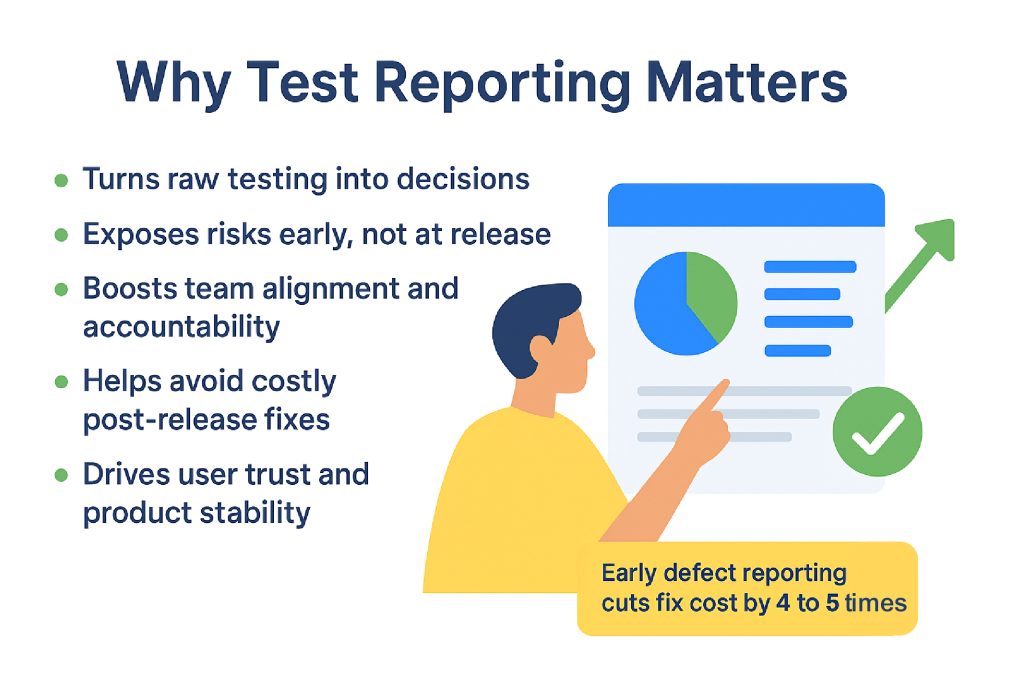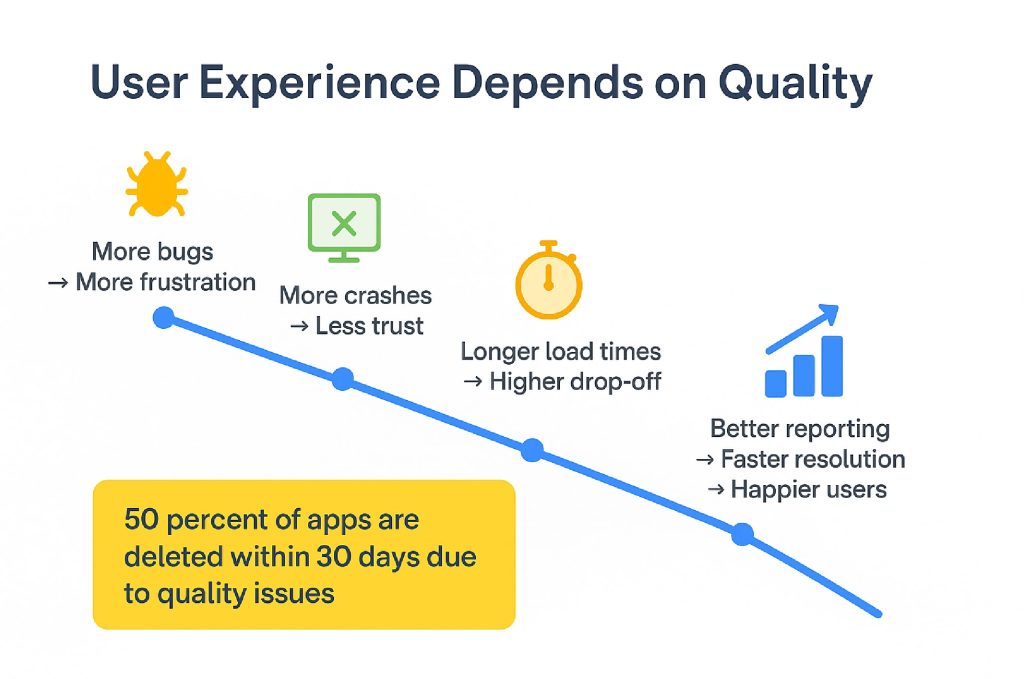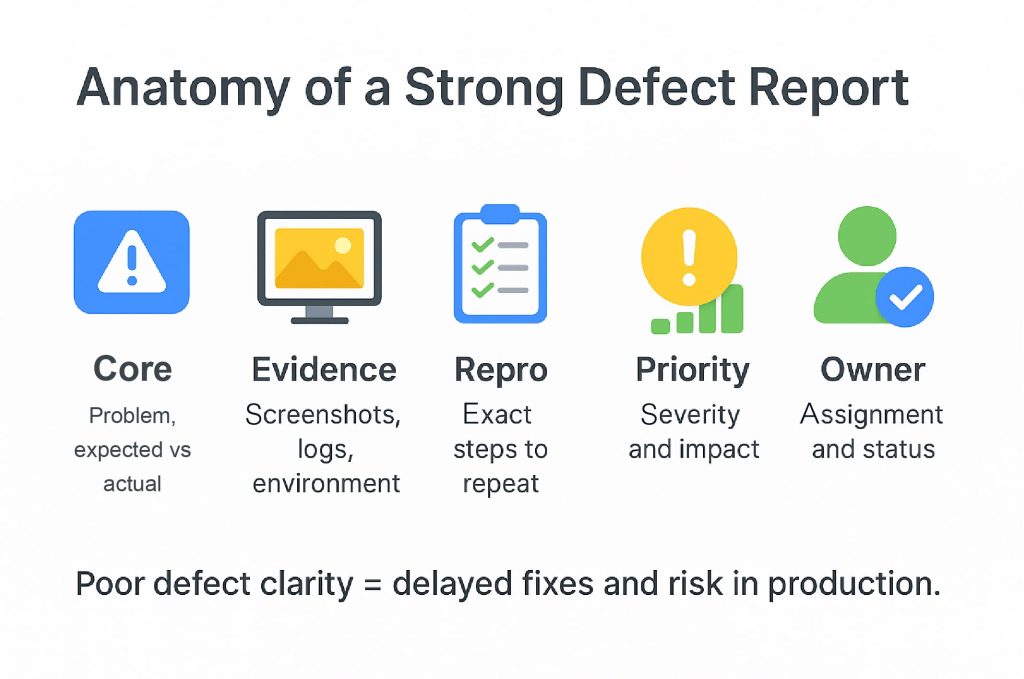Test reporting is perhaps one of the most important things in software testing and test management. It involves documenting testing activities, as well as the results and insights.
With good reporting, testers ensure clear communication and informed decisions. A well-crafted test report in software testing provides a snapshot of all the testing efforts made by the team. It highlights defects and confirms whether the software application meets release criteria.
That said, we came up with this guide to help you understand the fundamentals of test reports, including their types. We’ll also touch the the formats, key metrics, challenges and provide practical templates for testers and teams.

Test Reports in Software Testing: Key Takeaways
- Test reporting is not just documentation. It drives decision making, transparency and release confidence. Strong reports reduce the chances of defects slipping into production and protect the user experience.
- Fixing bugs early is far cheaper. Research shows poor software quality has already cost $2.41 trillion in the US, and early detection through clear defect reporting cuts fix costs by 4 to 5 times.
- Not all reports serve the same purpose. Incident reports, cycle reports, summary reports, execution reports, performance reports, security reports and UAT reports each answer different questions for different stakeholders.
- When reporting follows a standard format and focuses on insights rather than raw numbers, teams move faster. Standardised reporting has cut reporting time by 40% and increased stakeholder confidence by 25%.
- Performance and security reporting are now critical. 70% of applications fail their first performance benchmark. Global cybercrime has crossed $10.5 trillion annually, so performance and security gaps in reports directly threaten business continuity.
What is a Test Report in Software Testing and Its Importance?
Besides a general overview, let’s talk a bit more about test reports and what they really are.
A paper published by Capegemini discusses all about software testing and quality reports. It mentions that a test report is a formal, documented summary of all testing activities performed on a software product during a particular phase.
The main purpose of this report is to provide stakeholders with a clear view of the testing progress. Teams such as QA executives, developers and project managers also benefit from it. The current quality status of the software and any defects or risks that may impact release readiness are all clearly mentioned.
Furthermore, test reports present aggregated data, such as:
- Test Coverage
- Execution outcomes (pass/fail rates)
- Defect details, including severity and priority
- Qualitative assessments of the product quality
Unlike daily status updates, a test report consolidates data over an entire testing phase or the full lifecycle. It offers valuable insights that support decision-making and improve collaboration across teams.

As per research on the cost of poor software quality in the US, software bugs have caused losses of at least $2.41 trillion in the US alone. To ensure this amount doesn’t accumulate further too much, experts recommend early detection and clear documentation of defects through good test reporting. Doing so can reduce the cost of fixing bugs by 4-5 times.
Beyond the financial impact, effective test reports also improve user satisfaction. It is noted by Appsflyer that half of the installed mobile applications are uninstalled within the first 30 days. This happens due to poor user experience that’s caused by unresolved bugs, which test reports help catch early.
All in all, effective test reporting in software testing leads to:
- Improved communication and transparency across teams
- Objective visibility into product quality and risks
- Facilitated decision-making for go/no-go releases
- Documentation for audits and compliance
- Enhanced accountability and process discipline

Types of Test Reports in Software Testing
There are different types of test reports in software testing, and each one serves varied purposes. They cater to different stakeholders throughout the software development lifecycle.
Each type focuses on key aspects of the testing process. Actionable insights are added in the reports to improve product quality, manage risks and support release decisions.
- Test Incident Report (Defect Report in Software Testing)
The test incident report, which is also known as the defect report, is a document that records defects or issues that are discovered during testing. It includes detailed information such as:
- The nature of the defect(s)
- Severity
- Steps to reproduce
- Environment Details
- Assigned ownership for resolution
This report ensures transparency in defect management and enables quick triaging and prioritization.

Defect reporting needs to be done with care since it can accelerate bug resolution and reduce downtime. Release timelines are also improved.
We’d also like to add that properly managed defect reports significantly lower the risk of high-severity issues reaching production. Mind you, these are the issues that account for 40% of software failures, as per the research published by Vikas Sitaram Chomal.
- Test Cycle Report
A test cycle report summarizes the results of testing activities for a specific build or iteration. It provides insights into:
- Test execution counts
- Pass/fail rates
- Severity of detected defects
- Unresolved issues from prior cycles
This report acts as a bridge that links successive testing phases and sheds light on product stability and maturity over time. Regular cycle reporting improves testing process transparency and helps achieve faster identification of regression defects in Agile environments.
- Test Summary Report
This is the conclusive document that’s created at the end of a testing phase or release cycle. It outlines:
- Overall scope
- Testing coverage
- Execution outcomes
- Defect resolution status
Furthermore, the test summary report formally recommends whether the product is fit for release or requires further testing.
It is important for stakeholders and executives to assess product readiness. The paper published by Ravikiran Karanjkar on quality assurance as a business driver discusses that organizations that implement comprehensive QA practices and effective summary reports reduce post-release defects by 45%.

- Test Execution Report
The test execution report provides detailed feedback about each executed test case. It has the:
- Pass/fail status
- Test data used
- Execution time
- Tester comments
You get granular visibility for QA teams to track progress and investigate failures. Detailed execution reporting supports traceability and accountability. Both of these are factors that are linked to improved test coverage and defect capture rates.
- Performance Test Report
When it comes to the performance test report, it gathers quantitative metrics on:
- Application responsiveness
- Throughput
- Resource usage
- Scalability under various load conditions
This report highlights bottlenecks and performance regressions, helping QA teams ensure the system meets required service level agreements (SLAs). According to the paper on the experience with performance testing of software systems by Elaine J. Weyuker, 70% of tested applications fail initial performance benchmarks. This stat underscores the importance of these reports to avoid production incidents.
- Security Test Report
Security test reports document findings from vulnerability assessments and penetration tests.
They detail:
- Security risks discovered and their criticality
- Potential impact of the risks
- Recommended mitigations
Given the rising hacker threats and cybercrime costing the world $10.5 trillion annually, these reports are very important to maintain software integrity and compliance with industry standards.
- User Acceptance Test (UAT) Report
The UAT report highlights feedback and validation results from end-users or business stakeholders.
It confirms whether the software meets the stated business requirements and readiness for operational deployment.
Effective UAT reporting facilitates smooth handoffs between QA and operations. It reduces deployment issues and increases user satisfaction rates.
Summary Table for Types of Test Reports in Software Testing
| Test Report Type | Purpose | Key Contents | Primary Stakeholders |
| Test Incident Report (Defect Report) | Documents defects/issues found during testing | Defect ID, severity, description, reproduction steps, status, ownership | Testers, Developers, Defect Managers |
| Test Cycle Report | Summarizes activities and results for a specific test cycle | Test execution summary, defect status, new and unresolved issues, severity trends | QA Teams, Project Managers |
| Test Summary Report | Final overview of entire testing phase or release readiness | Test scope, execution results, defect resolution, quality assessment, release recommendation | QA Managers, Product Owners, Executives |
| Test Execution Report | Detailed case-level execution results and tester notes | Test case IDs, status (pass/fail), test data, comments, defects found | QA Analysts, Testers |
| Performance Test Report | Evaluates application performance and resource usage | Response times, throughput, scalability metrics, bottlenecks identified | Performance Engineers, DevOps Teams |
| Security Test Report | Documents findings of security vulnerabilities and fixes | Vulnerabilities found, risk levels, fix recommendations | Security Analysts, Compliance Teams |
| Traceability Matrix | Ensures coverage of requirements by tests | Requirement IDs mapped to test case IDs and coverage status | QA Leads, Business Analysts |
| User Acceptance Test (UAT) Report | Records end-user validation and business requirement fulfillment | User feedback, test results, issues raised, acceptance status | Business Stakeholders, End Users |
Test Report Format in Software Testing (What to Include in Every Report)
A good test report format in software testing serves as a structured template. One that organizes important information for clear communication, traceability and actionable insights.
Adopting a standardized report format ensures consistency across teams and projects. Doing so also improves transparency and enables stakeholders to make informed decisions about product quality and readiness.
That being said, a test report typically includes the following sections:
- Report Title, Date and Version
This section helps to identify the report at a glance. The project name, testing phase, version number and date of creation should be clearly mentioned at the top. Doing so helps maintain version history, which in turn leads to better audit trails and tracking of report updates.
- Test Objectives & Scope
Clearly defining the objectives and scope frames what the tests aim to validate. It also provides boundaries of testing coverage. You should specify functional areas, non-functional aspects and limitations. Well-defined objectives reduce scope creep and help prioritize testing efforts effectively.
- Overview of Test Environment & Configuration
The environment details, such as the hardware, software, network and configurations, always have to be documented. If done right, it ensures reproducibility and context for test results.
- Summary of Test Cases Executed (with Pass/Fail Counts)
This section acts as a sort of executive summary. One that highlights total planned test cases, how many were executed, passed, failed, blocked or skipped. It gives a quick health check of test progress and coverage. Metrics like the pass rate and defect density help teams prioritize fixes and retesting.
- Defect Summary with Severity & Status
This is an aggregated view of identified defects, categorized by severity (critical, major, minor) and current status (open, fixed, deferred). Adding this to your report aids risk assessment and resource allocation. As per the research paper on high-impact defects by Emad Shihab, identifying and addressing high-severity defects early via defect summaries can reduce post-release defects by up to 40%.
- Detailed Defect Description (for Incident/Defect Reports)
For defect-focused reports, comprehensive details include: Reproducibility steps, screenshots, logs and impact analysis. This facilitates efficient debugging and fixing. In the study “Survey Reproduction of Defect Reporting in Industrial Software Development,” 97 % of the participating developers rated these details, especially the steps to reproduce, as “very useful” information in defect reports.
- Key Metrics & KPIs
Incorporate performance indicators into the test reports. These include test coverage percentage, defect turnaround time, pass/fail ratio and trend analysis. Doing so provides quantitative insights into testing effectiveness. Furthermore, note that continuous monitoring of these KPIs supports process improvements and aligns testing outcomes with business goals.
- Recommendations, Risks & Mitigation Plans
This section offers informed suggestions based on test findings. And not just that, it identifies potential risks to product quality or delivery timelines and outlines mitigation strategies. Stakeholders want this more than anything else since proactive risk communication helps prevent costly failures.
- Stakeholders Sign-Off Approval
It is recommended to add an approval from each relevant stakeholder (QA lead, product owner, project manager) at the end of your test report. Obtaining a formal approval from these guys instills accountability and authorizes progression to the next phases, such as release or further testing.

Test Reporting Templates & Examples (Downloadable)
Test Case Execution Report:
Test Case Report:
Requirement Traceability Report:
Defects Report:
Cycle Comparison Report:
Key Metrics & KPIs in a Test Report
In a test report, including clear and meaningful KPIs is very important. These elements present the health, efficiency and quality of the testing efforts. That said, the following are some of the most commonly included key metrics, along with a bit on what they represent and how to write them in a test report.
- Test Coverage
What It Is: The percentage of the application’s code, features or requirements tested by executed tests.
What It Means: Higher coverage indicates more thorough testing, reducing the chance of undiscovered defects.
How to Write It (Example): “Test coverage for this cycle was 85%, covering all critical modules and 90% of functional requirements, ensuring comprehensive validation of key features.”
- Pass Rate
What It Is: The ratio of passed test cases to total executed test cases, expressed as a percentage.
What It Means: A high pass rate suggests software stability. While a low pass rate signals issues needing attention.
How to Write It (Example): “The pass rate for executed tests stood at 92%. This indicates strong stability in the tested features, with 8% test failures requiring defect investigation.”
- Defect Density
What It Is: Number of defects identified per unit size of the software (e.g., per thousand lines of code).
What It Means: Highlights defect concentration, guiding focused quality improvement efforts.
How to Write It (Example): “Defect density was measured at 0.4 defects per KLOC. Most defects are concentrated in the payment processing module.”
- Defect Severity Distribution
What It Is: Classification of defects by severity levels (critical, major, minor).
What It Means: Emphasizes risk areas that may block release or urgently require remediation.
How to Write It (Example): “Out of total defects, 10% were critical, 50% major and 40% minor. Priority actions are directed to critical issues before release.”
- Defect Resolution Time
What It Is: Average time taken to fix and verify defects once reported.
What It Means: Reflects responsiveness and efficiency of the development and QA process.
How to Write It (Example): “The average defect resolution time was reduced to 3 days. This is an improvement from the previous cycle’s 5 days.”
- Tests Executed and Test Execution Progress
What It Is: Number of test cases executed, passed, failed, blocked or skipped.
What It Means: Tracks test progress and identifies bottlenecks or incomplete areas.
How to Write It (Example): “Out of 500 planned tests, 450 were executed with a completion rate of 90%. Twenty tests were blocked due to environmental issues.”
- Automation Coverage
What It Is: The percentage of test cases automated compared to the total test suite.
What It Means: Indicates automation maturity and potential efficiency gains.
How to Write It (Example): “Automation coverage reached 65%. Regression testing is accelerated and faster feedback cycles are achieved.
- Defect Escape Rate
What It Is: The number or percentage of defects found in production post-release compared to total defects found pre-release.
What It Means: Reflects the effectiveness of the testing process in catching defects early.
How to Write It (Example): “Defect escape rate was 2%. Strong control is maintained over quality before production deployment.”
Best Practices for Test Reporting
Test reports need to be made carefully. The following are some of the proven approaches that help QA teams communicate testing progress efficiently.
- Define Clear Goals & Audience
Begin each test report by explicitly stating its purpose and identifying the target audience. Knowing who will read the report shapes the content, level of detail and presentation style.
For example, executives typically need concise yet high-level summaries. Ones that focus on risk and release readiness. On the other hand, developers and testers require detailed defect analyses and test case results.
You need to clearly align the report with the audience’s needs, so relevance and actionable outcomes are ensured.
- Use a Consistent and Standardized Format
Consistency across test reports enables stakeholders to quickly locate important information and compare the results over test cycles. Hence, it’s always good to establish a standardized template that includes sections such as:
- Objectives
- Test Summary
- Defect summary
- Environment details
- KPIs
- Recommendations
Uniform terminology and formatting will reduce confusion and errors. Especially in large teams or cross-project reporting. The article by Intrafocus on standardising reporting templates mentions that a company saw a 40% reduction in reporting time. As well as a 25% increase in confidence. All because they implemented a standardised reporting framework.
- Present Actionable Insights Clearly & Early
Start the report with an executive summary. It should highlight all the key data points. For example, the critical defects and release readiness timeline.
Additionally, mention what the data means and the actions required rather than just presenting raw numbers.
This focus on actionable insights helps stakeholders prioritize efforts and make informed decisions quickly. Delays are reduced and product quality is improved in the long run.
- Add Visual Aids & Automate Reporting Where You Can
Incorporate charts, graphs and heatmaps to visualize trends like defect density over time. These visual elements help stakeholders better comprehend the data. On top of that, they highlight patterns that are less obvious across the builds.
Furthermore, you should automate report generation by integrating a test management tool with reporting platforms, like Kualitee. Such a tool will help produce timely and accurate reports in mere seconds. This reduces manual workload and keeps your reports up-to-date.
- Balance Detail with Brevity
Look to include sufficient details. Test case results, defect descriptions and environment factors should all be added to a report as they support conclusions.
However, do note that while adding details is good, too many of them can also overwhelm the readers. So, find a balance. Use appendices or interactive dashboards for deep dives and keep the main report concise and focused on summary insights.
Doing so will respect stakeholders’ time constraints and maximize report impact. Both quick assessments and thorough investigations, when needed, will be supported.

Common Challenges in Test Reporting in Software Testing and How to Avoid Them
Despite trying their best, teams often face persistent challenges in creating and maintaining effective test reports. The following are some of these common pain points, along with how you can avoid them.
1. Maintenance Tax & Documentation Staleness
Many teams experience a “maintenance tax,” where overly detailed or rigid test documentation becomes outdated as software evolves.
In the words of a tester, “Documentation needs to be updated constantly, and nobody has time for that.” The rot of stale tests and contradictory scenarios dilutes confidence in reports and wastes effort.
To avoid this, you should adopt lean documentation focusing on high-impact tests. Regularly audit and update test cases to remove obsolete ones. Furthermore, use reusable test designs that minimize rework and try to automate test maintenance where possible. Doing so will keep test suites aligned with product changes.
The Dilemma of Step Detailing in Tests
There is an ongoing debate about how granular test steps should be. Detailed scripts can assist new testers and ensure repeatability. “Anyone can run the tests,” said a tester in this regard.
But on the other hand, many argue that such scripts are better suited for automation than manual testing and can hide test intent.
Considering this, you should calibrate the test case details based on team expertise and test purpose. For complex or regression tests, provide detailed steps. While for exploratory scenarios, you can rely on high-level charters or goals with light checklists.
Tooling Friction & Usability Bottlenecks
Teams frequently face friction when working with complex test management tools. Users report that platforms like Xray or Jira improve traceability but slow down test authoring dramatically. “3x as long to enter a test case (compared to spreadsheets),” is what a seasoned tester said.
The lack of bulk import, templating and fast editors frustrates testers and reduces adoption. You can avoid this by choosing Kualitee. It offers all the aforementioned things and allows quick report generation.
Philosophical Divide on Gherkin and BDD Practices
BDD adoption brings its own challenges. Some practitioners advocate for explicit, reusable Gherkin steps that map to automation. While others view Gherkin scenarios as high-level domain examples, not click-by-click scripts. “That’s checking, not testing,” argued one skeptic online.
Teams grapple with these different views and this impacts how test reporting documents scope and outcomes.
Hence, you should establish clear team guidelines on BDD usage, right from the start. Educate stakeholders on the benefits and limitations of detailed versus high-level Gherkin scenarios. Align reporting templates to accommodate both philosophies where possible.
Balancing Onboarding Needs with Testing Expertise
Test reporting must serve different skill levels, including new team members who are unfamiliar with domain intricacies. One manager observed, “I’ve never seen someone without domain knowledge run my tests.”
Crafting reports that support onboarding through detailed explanations and avoid overwhelming experienced testers with busywork requires thoughtful design and continuous refinement.
This is why you should structure reports and test cases with layered detail. Provide core test objectives and important steps upfront. Optional extended details can be added in appendices or linked documents. Also, try to pair experienced testers with newcomers to accelerate knowledge transfer and adapt reports over time.
Looking to Eliminate These Challenges Instead of Working Around Them?
If test reporting feels slow, manual or outdated, Kualitee is built to fix that from the ground up.
It automates reporting, centralizes insights and gives stakeholders real-time visibility without documentation overload.
Start your free trial and see how reporting becomes easier, not heavier.
Final Words
Test reports are your proof of effort, decisions and product health. When teams share clear reports, everyone stays aligned and risks show up early instead of at launch.
This avoids firefighting later and protects the user experience. Good reporting also builds trust. Leaders get real visibility, and teams get credit for the work they do instead of rushing quietly in the background.
As tech grows, weak reporting becomes a silent blocker. Missed defects, unclear status notes and scattered information slow teams down. Stakeholders get confused as well. Strong reporting does the opposite. It keeps quality consistent and speeds feedback. You get clean handoffs between QA, product and engineering teams.
The smart move is simple. Use structured formats and track meaningful metrics. Tools that reduce manual effort can be used to do things quickly. If you treat reporting as a habit, not a chore, your releases become smoother and your product becomes stronger over time.
Frequently Asked Questions (FAQs)
Q: What is a test report in software testing?
It is a documented summary of testing activities, results, defects and product quality status. A test report is used to inform stakeholders and guide decisions.
Q: What is the test report format?
It includes sections like objectives, scope, test results, defect summaries, metrics, environment details and recommendations for release.
Q: What are the types of test reports?
Common types include test incident reports, cycle reports, summary reports, execution reports, defect reports and performance/security reports.
Q: What are the 4 stages of testing?
Typically, these are test planning, test design, test execution and test reporting/closure.















































